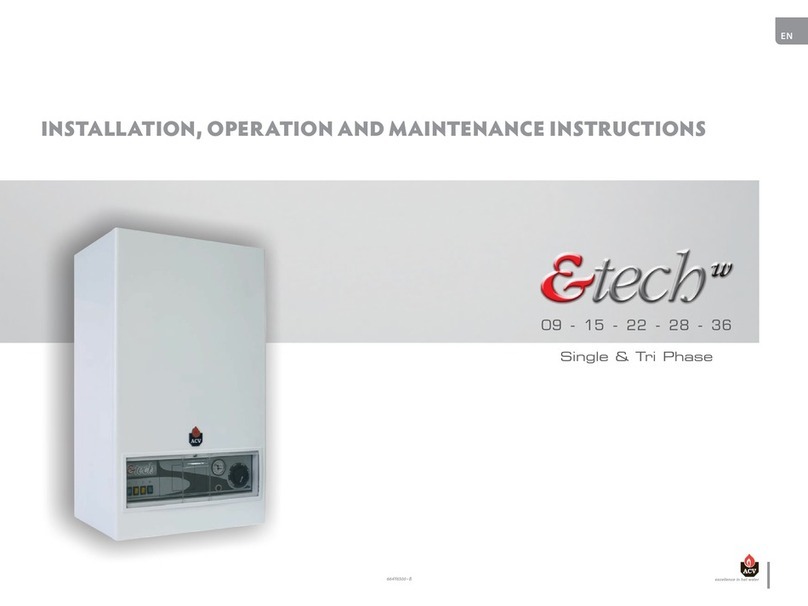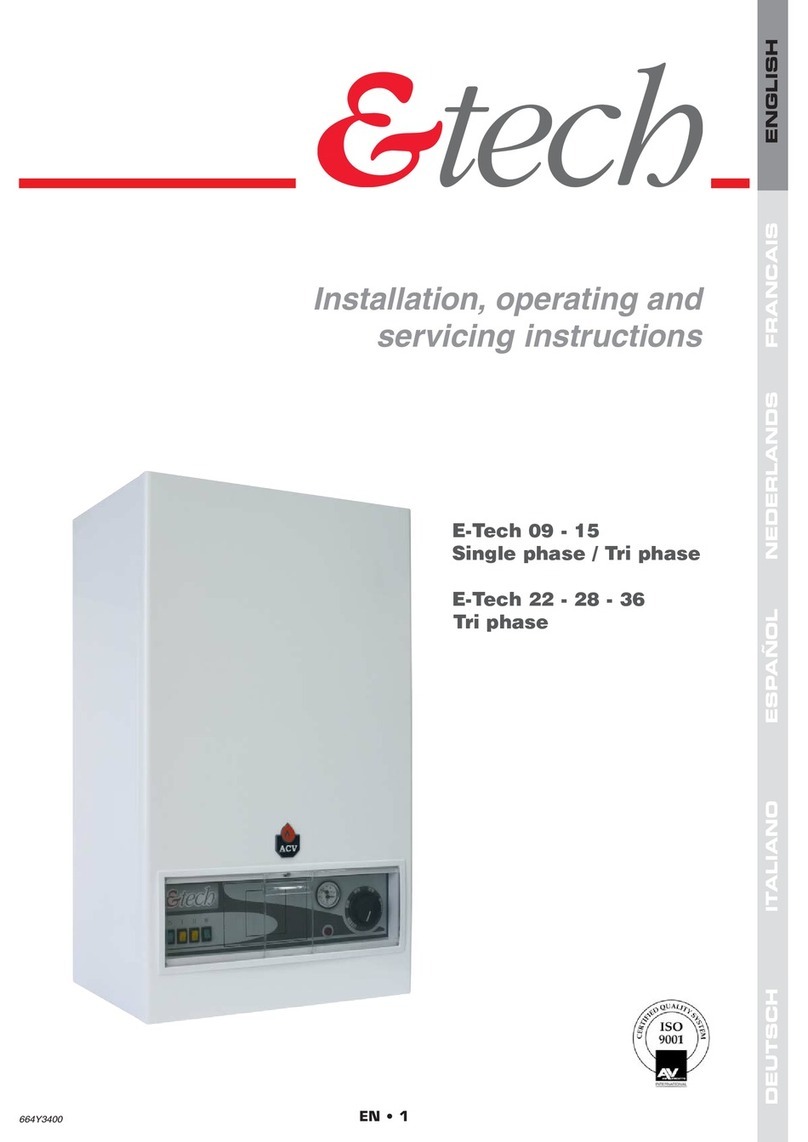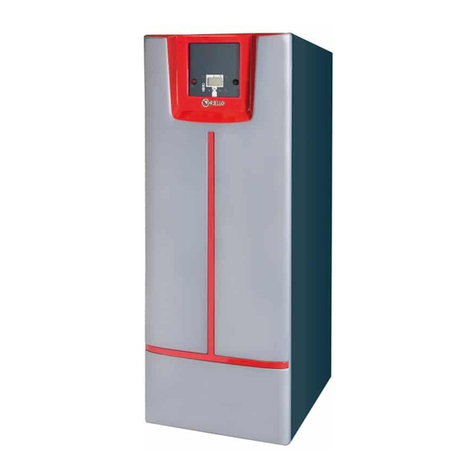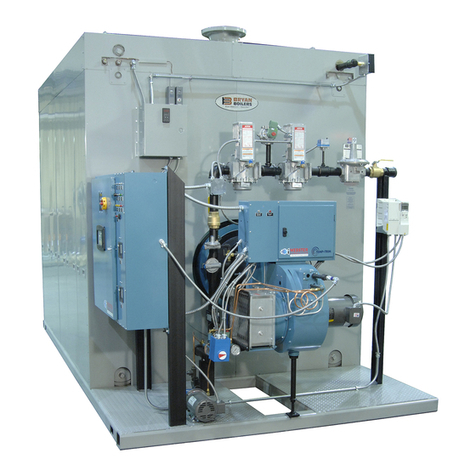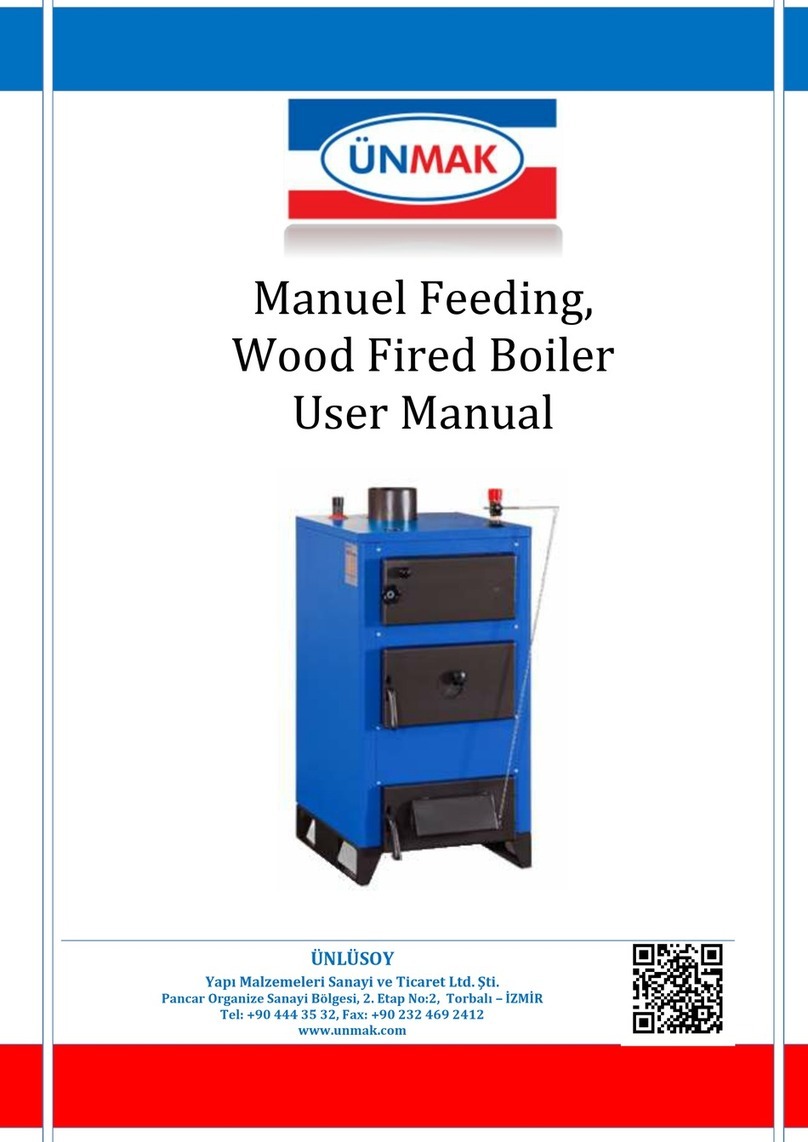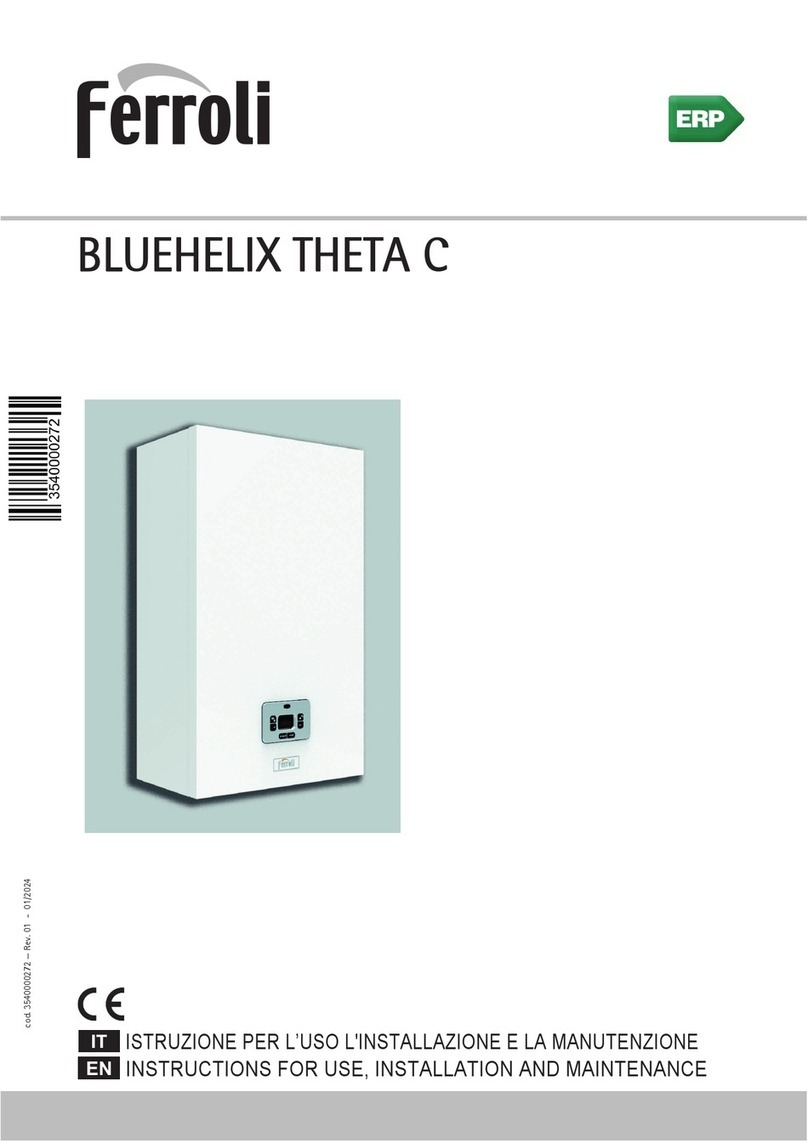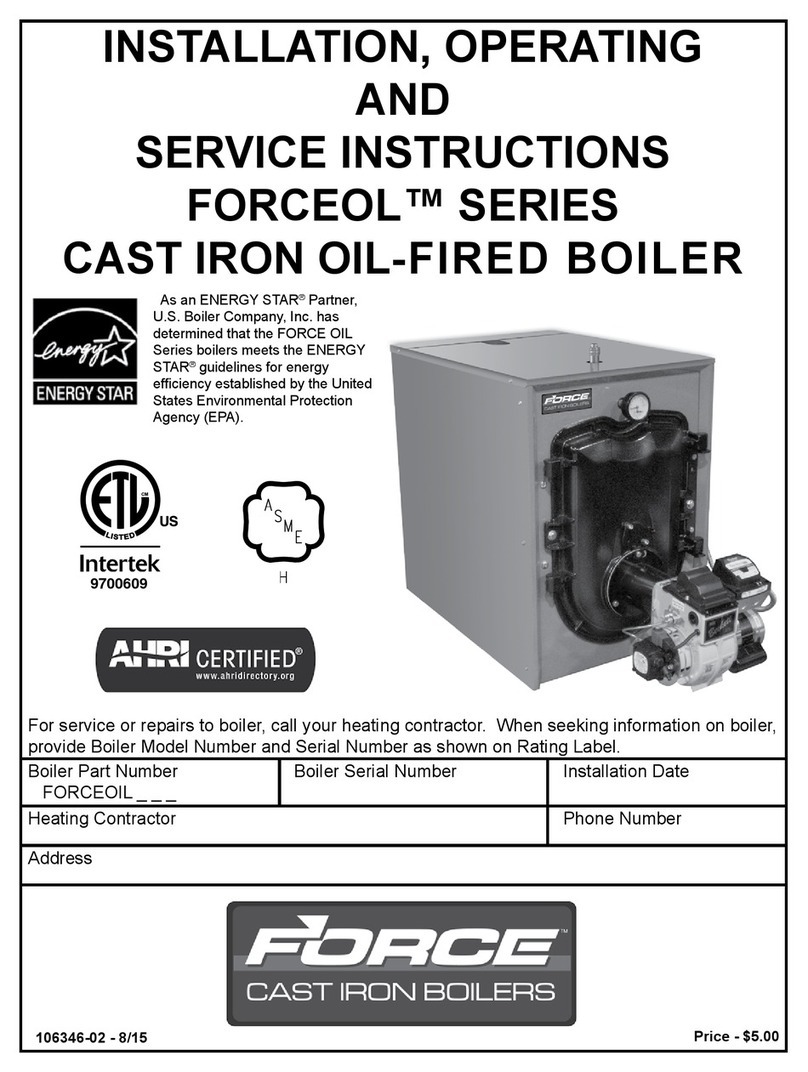E-Tech S 380 Owner's manual

03/02/2005 - 66401700.A
excellence in hot water
Installation, Operating and
Servicing Instructions
E-tech S 160 / 240 / 290 / 380

1
PEOPLE WHO SHOULD READ
THESE INSTRUCTIONS
These instructions are intended for:
- specifying engineers
- the installing engineers
- end-users
- servicing engineers
SYMBOLS
The following symbols are used in these instructions:
Essential instruction for operating the system
correctly.
Essential instruction for personal safety or
environmental protection
Danger of electrocution.
Risk of scalding.
WARNINGS
These instructions are an integral part of the equipment to which
they refer and must be supplied to the user.
The product must be installed and serviced by qualified engineers,
in compliance with the prevailing standards.
ACV accepts no liability for any damage resulting from incorrect
installation or from the use of components or fittings not specified by
ACV.
Failure to observe instructions regarding tests and
test procedures can result in personal injury or
pollution risks.
Note:
ACV reserves the right to modify the technical specifications and
components of its products without prior notice.
INDEX INTRODUCTION
INTRODUCTION 1
People who should read these instructions 1
Symbols 1
Warnings 1
DESCRIPTION 2
Overview 2
Operating principle 2
Construction features 2
TECHNICAL SPECIFICATIONS 4
Dimensions 4
General features 4
Maximum operating conditions 5
Domestic hot water performances 5
INSTALLATION 6
Boiler room 6
Heating connection 6
Domestic hot water connection 7
Controller kits 7
Electrical connections 8
COMMISSIONING 12
Filling the domestic hot water and heating circuits 12
ENTRETIEN 13
Service intervals 13
Servicing the boiler 13
Servicing the safety devices 13
Boiler draining 13
Spare parts 13
USER GUIDE 14
Using the boiler 14
Boiler shutdown 15
NOTE 16

OVERVIEW
•Combination boiler (central heating and domestic hot water).
•TANK-IN-TANK indirect storage type domestic hot water production.
•The central heating connections are designed so that they can be
connected in all three directions, this means that the boiler can be
installed against a wall or in a corner without having to leave any
free space (see page 6).
•Internal two-stage temperature control thermostat, which allows
the power to be adapted according to actual heat requirements.
•The boiler is fitted with expansion tanks, a safety valve, a
mano-thermometer, a water low safety device (pressure switch) and
a circulation pump.
OPERATING PRINCIPLE
The TANK-IN-TANK concept
The Etech’s series differs from traditional hot water producers in that
it has a tank immersed in the primary fluid contained in the outer
body. When there is a temperature drop in the boiler because the
central heating system or the domestic hot water circuit needs hot
water, the internal thermostat starts up the power on the immersed
electrical resistors. The heating elements quickly heat up the primary
fluid, thus creating a natural circulation around the tank.
Indirectly heating domestic hot water
This circulation allows easier heat exchange between the primary
fluid and the domestic water, all over the tank surface.The corrugations
on the outer shell of the tank increase the area of heat exchange still
further and thus speed up the process of heating the domestic
water.
Easy to set
With a single command, the water temperature of both the primary
circuit and the domestic hot water circuit can be set by the adjustable
thermostat situated underneath the tank in the primary circuit.
2
DESCRIPTION
CONSTRUCTION FEAURES
Outer body
The outer body containing the primary fluid is made of thick STW 22
steel.
TANK-IN-TANK type exchanger accumulator
The ring-shaped inner tank with its large heating surface for
producing domestic hot water is built of Chrome/Nickel 18/10
stainless steel. It is corrugated ocer its full height by an exclusive
production process and entirely argon arc welded by the TIG
(Tungsten Inert Gas) method.
Isulation
The boiler body is fully insulated by rigid polyurethane foam, with a
thickness of 70mm, with a high thermal insulation coefficient. This is
sprayed onto the tank without using any CFCs.
Casing
The boiler is covered by a steel jacket which has been scoured and
phosphated before being stove enamelled at 220 °C.
Heating elements
nding on the model, the boiler is fitted with either six or seven
etachable stainless steel AISI 304L immersion heaters.
Controller
Control
thermostat
ON/OFF
switch
Power
selection
switch
Summer/Winter
selector switch
Combined temperature
and pressure gauge
Power
selection
switch
Safety
indicator
light
Safety
thermostat
Control panel

3
DESCRIPTION
Domestic hot
water return
Domestic hot
water outlet
Insulation
Central heating
flow pipe
Primary
expansion
vessel
Tank-in-Tank
heat exchanger
Drain cock
Control thermostat
Primary circuit
Primary
safety valve
Domestic cold
water inlet
Heating return
Low water
pressure switch
Heating resistors

4
DIMENSIONS
The units are delivered fully assembled, tested and packed on a timber base with shockproof edges and protected by heat-shrunk plastic film.
On reception and after unpacking, check the equipment for domage. For transport purposes, refer to the weight and dimensions give below.
TECHNICAL SPECIFICATIONS
B C
GF
D
A
E
I J
KK
H
L
E-tech S 160 E-tech S 240 E-tech S 290 E-tech S 290 E-tech S 380 E-tech S 380
single phase tri phase mono phase tri phase
Output kW 14.4 14.4 14.4 28.8 14.4 28.8
Operating voltage Volt 230 230 230 3 x 400 + N 230 3 x 400 + N
Total capacity L161 242 295 295 394 394
Primary circuit capacity L55 68 97 97 127 127
Central heating connections Ø1” 1” 1” 1” 1” 1”
Domestic hot water connections Ø3/4” 3/4” 1” 1” 1 1/2” 1 1/2”
Hot water tank exchange surface m21.26 1.87 2.0 2.0 2.6 2.6
Weight when empty kg 115 155 202 202 230 230
Domestic hot water max. pressure bar 10 10 10 10 10 10
Central heating max. pressure bar 333333
Expansion tank 1 x 8 L 1 x 8 L 2 x 8 L 2 x 8 L 2 x 8 L 2 x 8 L
Max. T° setting °C 85 85 85 85 85 85
A mm B mm C mm D mm E mm F mm G mm H mm I mm J mm K mm L mm
160 1432 620 720 1282 290 43 265 405 310 127 180 126
240 1953 620 720 1800 290 43 265 405 310 127 180 126
290 1784 720 800 1627 300 92 265 435 360 94 135 96
380 2134 720 800 1985 300 92 265 435 360 94 135 96
GENERAL FEATURES

5
TECHNICAL SPECIFICATIONS
MAXIMUM OPERATING CONDITIONS
Maximum operating pressure (tank full of water)
- Primary circuit: 3 bar
- Secondary circuit: 10 bar
Test pressure (tank full of water)
- Primary circuit: 4.5 bar
- Secondary circuit: 13 bar
Operating temperature
Maximum temperature: 90 °C
Water quality
• Chlorures: < 150 mg/l (304)
< 2000 mg/l (Duplex)
• 8≥ph≥6
DOMESTIC HOT WATER PERFORMANCES
E-tech S 160 E-tech S 240 E-tech S 290 E-tech S 290 E-tech S 380 E-tech S 380
single phase tri phase mono phase tri phase
Peak delivery at 40 °C L/10’ 310 532 645 660 855 870
Peak delivery at 45 °C L/10’ 250 452 548 561 725 739
Peak delivery at 60 °C L/10’ 168 294 356 365 468 472
Peak delivery at 40 °C L/60’ 690 880 990 1305 1200 1516
Peak delivery at 45 °C L/60’ 570 750 845 1090 1021 1270
Peak delivery at 60 °C L/60’ 375 465 527 625 636 752
Continuous delivery at 40 °C L/h 413 413 413 826 413 826
Continuous delivery at 45 °C L/h 354 354 354 708 354 708
Continuous delivery at 60 °C L/h 248 248 248 415 248 448
Start-up time [10-80°C] min 61 93 113 91 150 120
Start-up time [15-65°C] min 44 66 81 65 107 86

6
BOILER ROOM
Important
•Keep vents free at all times.
•Do not store inflammable products in the boiler room.
•Do not store corrosive products near the boiler, such as paints,
solvents, chlorine, salt, soap and other cleaning products.
Accessibility
The boiler room must be large enough to allow proper access to
the boiler. The following minimum distances around the boiler are
required:
- at the front: 500 mm
- above: 300 mm
- on the central heating connection side: 150 mm
This boiler can be connected to the central heating circuit in any one
of three directions.
HEATING CONNECTION
The drain cock (8) and safety valve (2) must be connected to the
waste water disposal system.
The boiler is fitted with an expansion chamber with a
capacity of:
• 8 litres on Etech’s 160 and 240 models.
• 16 litres on Etech’s 290 and 380 models.
If the expansion volume is not sufficient for your
needs then it is possible to install an additional tank.
The boiler is fitted with a safety valve set to 3 bar.
1. 3-way valve
2. Safety valve preset to 3 bar with pressure gauge
3. Heating pump
4. Non-return valve
5. Expansion vessel
6. Controller
7. Isolation valves
8. Drain cock
INSTALLATION
Base
The boiler must be laid on a base made of non-combustible materials.
YY
1
2
3
4
77
6
5
5
8

7
INSTALLATION
DOMESTIC HOT WATER CONNECTION
Pressure reducer
If the water mains pressure is greater than 6 bar, a pressure reducer
calibrated to 4.5 bar must be fitted.
Safety unit
The tank safety unit must be ACV approved and calibrated to 7 bar.
The valve discharge must be connected to the waste water disposal
system.
Domestic hot water expassion tank
Installing a domestic hot water expansion tank avoids any risk of
overpressure due to pressure surges and also makes sure that
there is a always water flowing through the safety unit when refilling
the domestic hot water tank.
Hot water circulation
If the tank is located a long way from the point of use, then
installing a closed recirculation circuit ensures that a faster supply
of hot water is always available.
Descriptions
1. Expansion relief valve
2. Pressure reducing valve
3. Thermostatic mixing valve
4. Hot water secondary pump (it fitted)
5. Non-return valve
6. Hot water expansion vessel
7. Stop cock
8. Draw-off valve
9. Drain cock
CONTROLLER KITS
KIT 1: ACV 13.00 / Basic
Basic kit for regulating initial flow temperature according to weather
conditions. It comprises: a temperature regulator with analogue
clock, wall-mounted water temperature sensor (-30/130 °C), external
sensor (-30/50 °C), 3-pin servomotor SQY 31 230 V and an
intermediate base.
KIT 2: ACV 13.00 / Standard
Basic kit for regulating initial flow temperature according to weather
conditions. It comprises: a temperature regulator with analogue
clock, wall-mounted water temperature sensor (-30/130 °C), external
sensor (-30/50 °C), 3-pin servomotor SQY 349,230 V and an
intermediate base.
1
2
4
6
5
7
9
8
3
IMPORTANT
As a safety measure against burns, we strongly advise
installing a thermostatic mixing valve (recommended
temperature: 60° C).
Optional fittings available
Groupe de sécurité Ø 3/4”
Réducteur de pression Ø 3/4“
Mitigeur thermostatique Ø 3/4”
Vase d’expansion 5 litres

8
INSTALLATION
ELECTRICAL CONNECTIONS
Control circuit power supply
The control circuit is automatically powered from the power circuit. It is
also protected by a magneto-thermal circuit breaker.
Control wiring diagram
It is important to switch the boiler off before
carrying out any work.
1
34
56789
C
2
C2.1. 2.2.
1.1. 1.2.
A1 A2
12
110 11
12 13
14 15
18 19
br
br v
r
r
oo
w
o
w
or
w
pgr
w
o
y
w
v
r
yr
r
r
o
21
bk
b
b
b
b
b
b
b
b
C1
2
20
o
bk
E-Tech `S` Single Phase Control Circuit - With shunt circuit (factory wired)
CABLE COLOUR CODES
bk- black
br- brown
r-red
w-white
y- yellow
o - orange
b - blue
v - violet
p - pink
gr - grey
All bold numbers indicate a DIN rail terminal connection
Boiler Stat
(78 - 53°C)
PLEASE NOTE: Due to the potential risk of ELECTRIC SHOCK this section of the manual is intended for use
by a service engineer or qualified electrician, not the user
230 - 240 V ac
3 amp
MCB
Panel
On Off
Switch
High Temp
Limit
(manual reset)
Water
Pressure
Switch
Optional
Internal Or
External
Boiler Control
Clock
High Temp
Limit
(Auto Reset)
Boiler Stat
(85 - 60°C)
Panel
Stage 1
Switch
Panel
Stage 2
Switch
Optional Internal -
External Clock Supply
Circulating
Pump
Stage 1
Power
Relay 1
Stage 1
Power
Relay 2
Stage 2
Power
Relay 1
Stage 1
Delay
Timer
Heating Valve
(Not Supplied)
Panel
Heating
Switch
Switch
Indicator
Switch
Indicator
Switch
Indicator
Remove Link If
Option Used
Optional
External Heating
Clock or Stat
M
Switch
Indicator
Lockout
Indicator
Remove Link If
Clock Used
r

9
INSTALLATION
E-Tech `S` Tri Phase Control Circuit - With shunt circuit (factory wired)
CABLE COLOUR CODES
bk- black
br- brown
r-red
w-white
y- yellow
o - orange
b - blue
v - violet
p - pink
gr - grey
All bold numbers indicate a DIN rail terminal connection
Boiler Stat
(78 - 53°C)
PLEASE NOTE: Due to the potential risk of ELECTRIC SHOCK this section of the manual is intended for use
by a service engineer or qualified electrician, not the user
230 - 240 V ac 3 amp
MCB
Panel
On Off
Switch
High Temp
Limit
(manual reset)
Water
Pressure
Switch
Optional
Internal Or
External
Boiler Control
Clock
High Temp
Limit
(Auto Reset)
Boiler Stat
(85 - 60°C)
Panel
Stage 1
Switch
Panel
Stage 2
Switch
Optional Internal -
External Clock Supply
Circulating
Pump
Stage 1
Power
Relay 1
Stage 1
Power
Relay 2
Stage 2
Power
Relay 1
Stage 2
Power
Relay 2
Stage 1
Delay
Timer
Heating Valve
(Not Supplied)
Panel
Heating
Switch
Switch
Indicator
Switch
Indicator
Switch
Indicator
Remove Link If
Option Used
Optional
External Heating
Clock or Stat
Switch
Indicator
Lockout
Indicator
Remove Link If
Clock Used
1
34
56 789
C
2
C2.1. 2.2.
1.1. 1.2.
A1 A2
12
110 11
12 13
14 15
18 19
r
br
br v
r
r
oo
w
o
w
or
w
pgr
w
o
y
w
v
r
yr
r
r
o
21
bk
b
b
b
b
b
b
b
b
M
C1
2
20
o
16
w
17
r
y
A2A1
r
b
bk
Stage 2
Delay
Timer

10
Connecting the accessories
The electrical accessories are connected to the numbered terminals
on the control terminal block as shown on the control wiring diagram.
Power wiring diagram
•For the mono phase model (In top of the page 11)
•For the tri phase model (In bottom of the page 11)
Electrical safety devices
•The boiler must be effectively earthed.
•Abox fitted with a magneto-thermal circuit breaker must be fitted on
the outside of the boiler. This is to protect the boiler and allow the
power supply to be switched off during servicing or other work on
the boiler.
First make sure that the system complies with all
current standards.
•To avoid any risk of electrocution, the electrical circuit must be
fitted with a differential circuit breaker.
•The control circuit is protected by a magneto-thermal circuit breaker.
Compliance
The installation must be carried out in accordance with the current
local technical standards and legislation.
Electrical terminal block
INSTALLATION
Power
terminal
block
Calibrator
relay
Control
terminal
block
Magneto-therminal
circuit breaker
Power
Switches

L
N
3 x Red
3 x Red
3 x Blue
3 x Blue
To Boiler Body
Green / Yellow
Stage 1 Power Relay 1
Stage 1 Power Relay 2
Stage 2 Power Relay 1
To Control
Circuit MCB
E-Tech Single Phase
Power Wiring
L1
L2
L3
N
To Co ntrol
Circuit MCB
4 x Orange
4 x Black
4 x Red
4 x Blue
To Boiler Body
Green / Yellow
Stage 1
Power Relay 1
Stage 1
Power Relay 2
Blue
Red
Black
Orange
Blue
Red
Black
Orange
Orange
Black
Red
Blue
Orange
Black
Red
Blue
Stage 2
Power Relay 2
Stage 2
Power Relay 1
E-Tech S Tri Phase
Power Wiring
11
INSTALLATION

12
COMMISSIONING
FILLING THE DOMESTIC HOT WATER AND
HEATING CIRCUITS
1. Fill the domestic hot water circuit and bring it up to pressure
IMPORTANT
The hot water tank must be pressurised before the
heating circuit is filled.
2. Fill the central heating circuit making sure that any air in the upper
part of the boiler and any air in the system is bled.
3. Remove the front of the boiler.
4. Check the electrical connections paying particular attention to the
quality of the connections on the power circuit terminals.
5. Set all the switches on the control panel to the OFF position and
set the internal magneto-thermal circuit breaker to ON. Replace
the front of the boiler.
6. Switch the boiler on from the external box.
7. Set the on/off switch to the ON position and the summer/winter
selector switch to the winter position.
8. After allowing the circulator to work for a few minutes, set the
on/off switch to the OFF position, bleed the circulation pump and
make sure that both the boiler and the system are properly bled.
Adjust the pressure to the static pressure (1 bar = 10 m – 1.5 bar
= 15 m) + 0.5 bar.
9. The boiler is now ready to operate. Set the on/off switch to the ON
position, the summer/winter selector, the half and full power
switches and the control thermostat all to the desired positions
After a few days in operation checkfor any leaks the
quality of the electrical connections and also make sure
there is no air in either the boiler or the system.
Switch the power supply off from the outside box
before carrying out any work.

13
MAINTENANCE
SERVICE INTERVALS
ACV recommend that boilers should be serviced at least once a year.
This servicing work should be carried out by a competent technician.
SERVICING THE BOILER
1. Set the on/off switch on the control panel to the OFF pos tion and
switch the power off from the external box.
2. Remove the top panel and the front and carry out a visual
inspection of the boiler looking out for any leaking water.
3. Inspect the wiring looking for any sign of overheating.
4. Check that the screws on the connection terminal block are
properly tightened.
5. Replace the front and the top panel.
6. Switch the boiler back on again.
SERVICING THE SAFETY DEVICES
-Check that the thermostats and safety devices are working
properly.
-Check the safety valves on both the central heating and the hot
water circuits.
DRAINING THE BOILER
Water flowing out of the drain cock may be
extremely hot and could cause severe scalding.
Keep people away from discharges of hot water.
Draining the heating circuit
1. Switch the power to the boiler “OFF” at the mains switch installed
by the electrician.
2. Close the boiler system’s isolating valves (1).
3. Connect a hose to the drain cock (2) and make sure that it is
properly connected.
4. Open the drain cock and allow hot water to flow out into the waste
water disposal system, check that air is being taken into the
system, by opening the air vent, for instance.
5. Once you have finished, put the drain cocks back into their
original positions and adjust the pressure to the static pressure
+ 0.5 bar.
Draining the domestic hot water circuit
1. Switch the mains power to the boiler off at the external switch
installed by the electrician.
2. Close valves (A) and (B).
3. Open valves (C) and (D) (first C then D).
4. Let the water drain away.
5. When you have finished, return the valves to their initial positions.
To allow the tank to be emptied, valve (C) must be
situated at ground level.
SPARE PARTS
Please refer to the specific document available from ACV or your
distributor.
11
2
YY
A
C
B
D
60
85

14
7 - Safety thermostat
When the temperature in the boiler exceeds 103 °C, the manually
reset safety thermostat is started up.
8 - Boiler shutdown indicator light
This light is lit when the safety thermostat starts up or when the
water pressure in the boiler is too low.
Central heating system gauge pressure
Your boiler is fitted with a central heating safety valve, set to 3 bar,
and with a pressure gauge.
First make sure that the water in the system is still pressurised.
When cold and after the air in the system has been bled, the
pressure gauge should show a pressure of between 1 and 2,
depending on the height of the building: (1 bar = 5m / 1.5 bar = 10
m and 2 bar = 15 m). To add water, open the filling valve (Fig. 2a and
2b on page 3). Make sure that the drain cock is properly closed after
filling and isolate the filling circuit from the central heating circuits.
Bleed the air in the system to get an accurate water pressure
reading.
Safety valve (central heating)
A monthly inspection is recommended:
Lift the lever on the emptying device for a few seconds to ensure that
the safety valve is working properly
The water which may flow out of the safety
valve is very hot and may cause serious burns.
The pipe discharging into the waste water
disposal system should be open to the
atmosphere.
Make sure there is nobody near the flow of hot
water.
If you notice anything unusual after this short trial,
please inform the installing engineer.
Safety unit (domestic hot water)
A monthly inspection is recommended:
Lift the lever on the emptying device for a few seconds to ensure that
the safety valve is working properly.
The water flowing out of the safety unit may be
extremely hot.
The pipe discharging into the waste water
disposal system should be open to the
atmosphere.
Make sure there is nobody near the flow of hot
water.
If you notice anything unusual after this short trial,
please inform the installing engineer.
USER GUIDE
USING THE BOILER
Your system should be serviced at least once year by
a qualified engineer.
If the boiler is subject to heavy use, it may require
servicing more than once a year - consult your service
engineer for advice.
Before carrying out any work on the boiler, switch the
power off at the mains switch fitted in the boiler room
by the electrician.
Understanding the control panel
There are no user parts inside
the control panel.
1 - ON/OFF switch
This must be used to switch the boiler off before carrying out any
work on it.
2 - Power selection switches
The control panel is fitted with two switches allowing the user to
select the boiler power according to his needs.
When only the first switch is pressed down, the boiler power is
limited to the first stage using +/- half of the power (ideal in summer).
In order for the boiler to run at full power, both of the switches must
be pressed down.
3 - Summer/Winter selector switch
“Winter” position: provides both domestic hot water and central
heating functions. “Summer” position: The central heating circulator
is switched off. Only the domestic hot water function is provided. If
there is not enough hot water available, we recommend setting the
thermostat (9) to a higher value.
When the weather turns cold again, simply select “Winter” to
reactivate the heating system.
4 - Controller
Please see the enclosed instructions if you have chosen this option.
5 - Mano-thermometer
Reads the boiler primary circuit (central heating) temperature and
pressure directly.
6 - Thermostat adjustable between 60 and 85° C
Central heating systems are generally designed to operate at a
maximum of 80° C.When used at lower temperatures, a 3-way mixer
valve installed on the heating flow pipe (see Fig. 2b on page 3)
allows the temperature to be set manually or, if you decide to install
a regulator (§ 2.2.4), automatically.
We recommend that you set the thermostat to the maximum values
to get the best out of the domestic hot water system.
There is a risk of burns from hot water!
The water stored in the domestic hot water tank in the boiler can be
at a very high temperature.
In all cases, install the thermostatic mixer (Fig. 3b on page 4) on the
domestic hot water flow pipe which must not exceed 60° C.
A mixer or mixing valve at each point of use is recommended.

15
BOILER SHUTDOWN
If the red light on the control panel lights up, this indicates an
operating fault.
1. Check the boiler pressure, it should be between 1 and 2 bar
depending on the height of the building.
2. Once you have checked the pressure, wait until the boiler has
cooled down before resetting the safety thermostat.
3. Unscrew the safety thermostat’s protective cap.
4. Restart the thermostat using a blade end.
5. If the system shuts down again, please inform the installing
engineer.
To ensure your system operates properly, have it
professionally serviced once a year before the cold
weather starts.
USER GUIDE
Controller
Control
thermostat
ON/OFF
switch
Power
selection
switch
Summer/Winter
selector switch
Combined temperature
and pressure gauge
Power
selection
switch
Safety
indicator
light
Safety
thermostat
Control panel
Table of contents
Other E-Tech Boiler manuals
Popular Boiler manuals by other brands
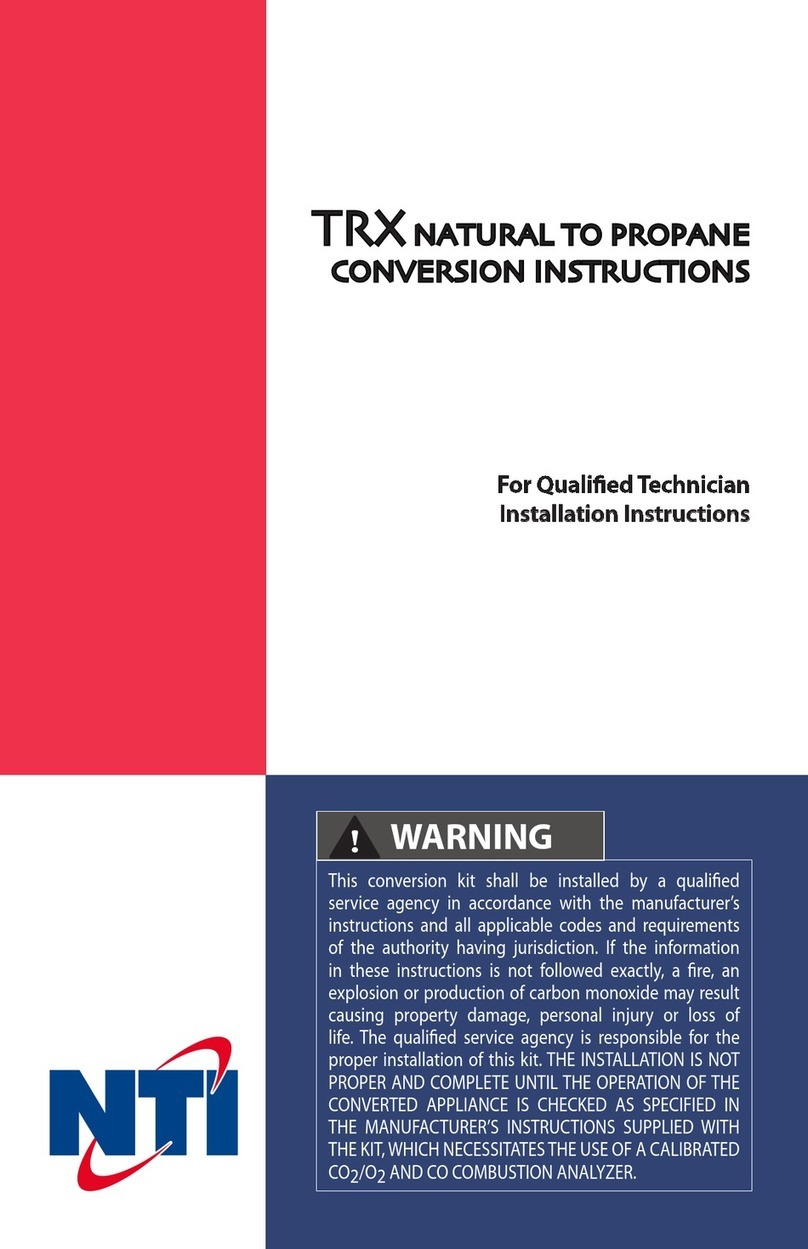
NTI
NTI TRX085 Conversion instructions

Alde
Alde Compact 3020 HE Operating and installation instructions
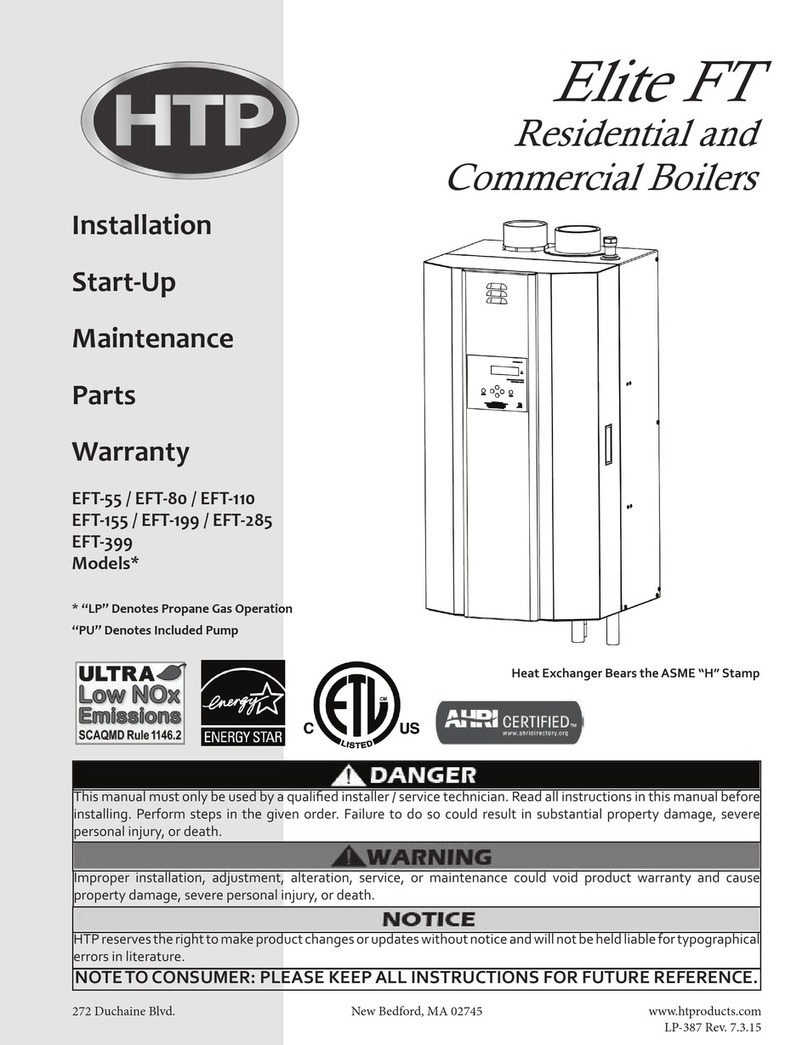
HTP
HTP Elite FT Installation, start-up, maintenance, parts, warranty

Mikrofill
Mikrofill Ethos Series Technical documentation

DeDietrich
DeDietrich Innovens MCA 35 Installation and service manual

Viessmann
Viessmann Vitodens 100 operating instructions

Buderus
Buderus Logamax plus GB162-80 kW installation instructions
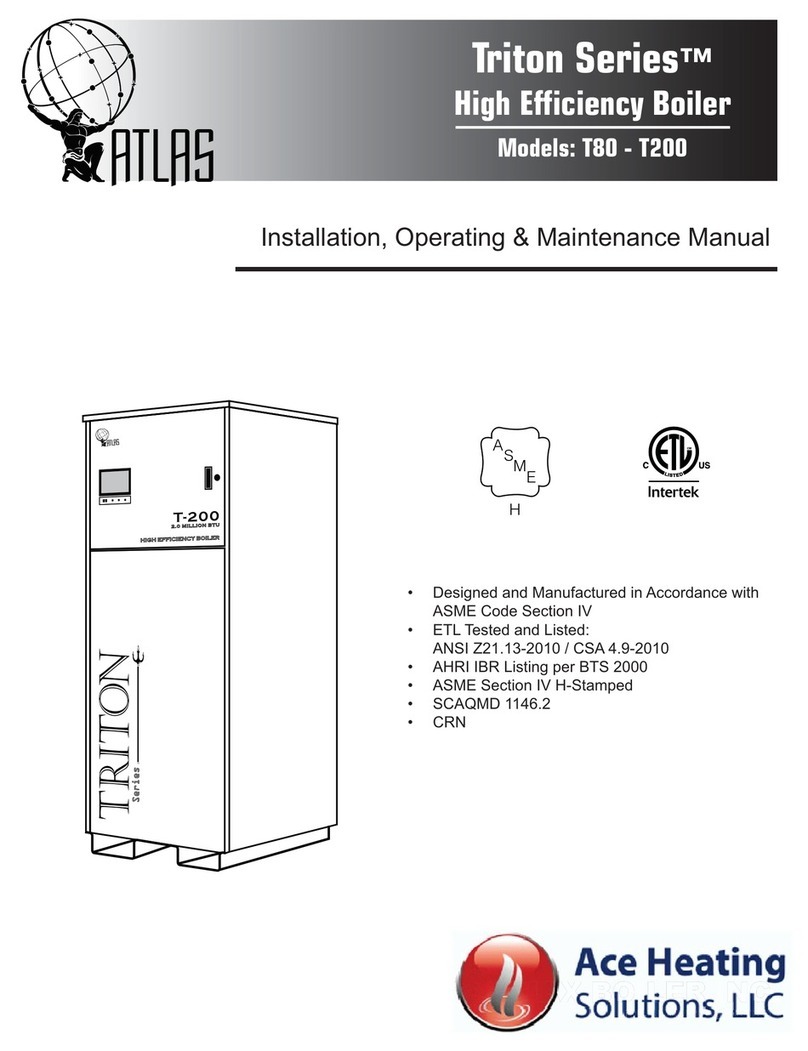
Atlas
Atlas Triton T-80 operating manual

Ferroli
Ferroli BLUEHELIX TECH RRT 28 C Instructions for use, installation and maintenance

Vivadens
Vivadens MCR 24/28 BIC PL user guide
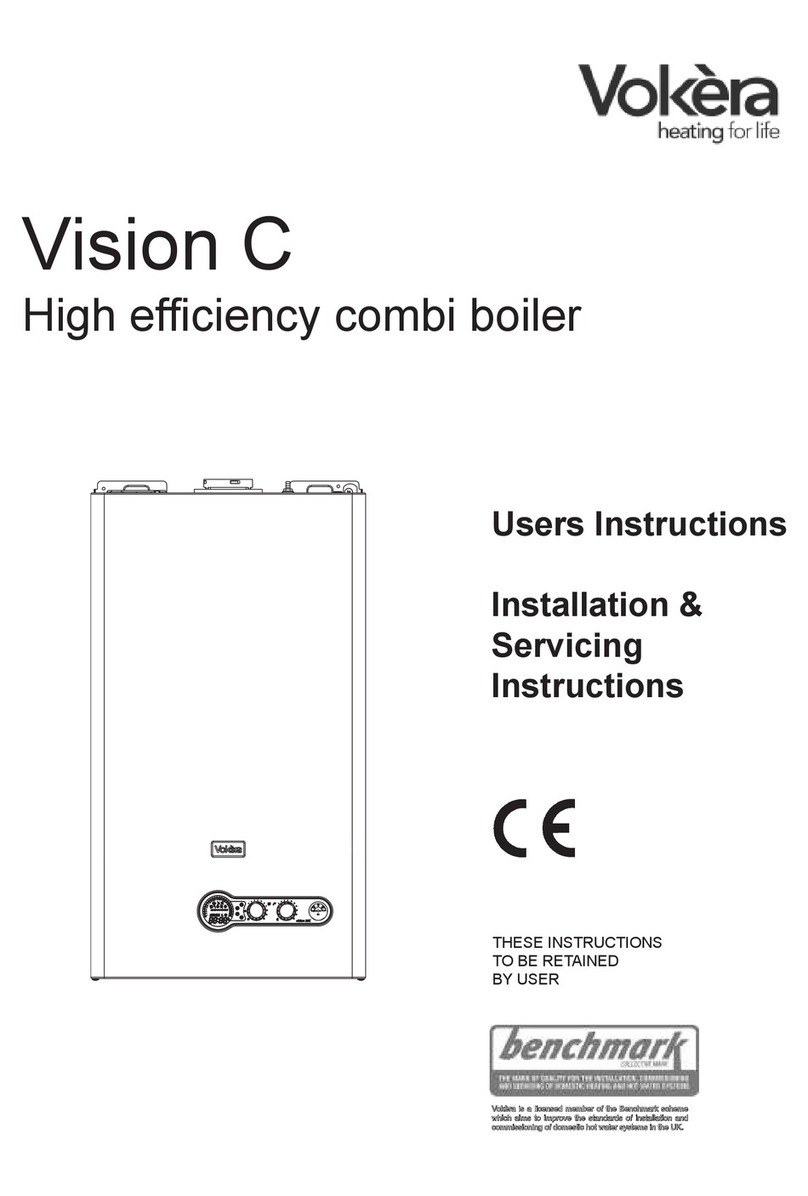
VOKERA
VOKERA Vision C User instructions

NuVision
NuVision Energy Saver Commissioning instructions

